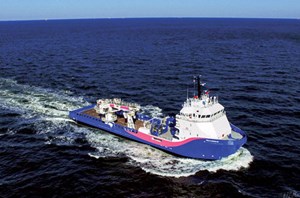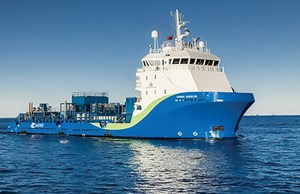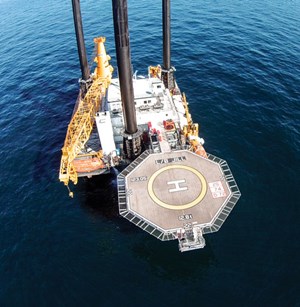
As the newly commissioned Shelia Bordelon ultra-light intervention vessel (ULIV) plies the deep waters of the Gulf of Mexico, she also will be carrying a message that hits close to home for her creator.
The namesake of Bordelon Marine President and CEO Wes Bordelon’s mother-in-law, a breast cancer survivor, the second addition to the shipbuilder’s Stingray ULIV series will carry the familiar pink stripe across its bow, symbolic of the Susan G. Komen for the Cure foundation, Fig. 1. In partnering with the New Orleans affiliate of the global breast cancer awareness organization, Bordelon also is donating a portion of the vessel’s profits to the foundation. “This is a great cause, and the response from everyone has been overwhelming,” Bordelon says. “The Shelia Bordelon will carry the pink stripe this year and probably next.”
Along with its more philanthropic message, the Shelia Bordelon also will deliver an economic missive to operators: During these trying times, you don’t need to pay for bigger when smaller works just fine.
“There’s a lot of subsea intervention work going on in the deep water, and, traditionally, that work has been done with larger vessels, with 250-ton and 50-ton cranes,” Bordelon said. “So, you have this massive vessel doing work that is both large and small in scale. We saw that as the subsea intervention infrastructure grows, there are a lot of both large and smaller jobs that need to be done. So, we decided to design a boat that does just the small things, and at a lower price point. We can do a wide range of smaller things, and then they can charter a bigger boat only when they need it, like for the large frac jobs.”

In a related development, Baker Hughes’ StimFORCE stimulation vessel, which is installed on Bordelon Marine’s original 255-ft new generation Stingray class vessel, has recorded an impressive first year of operation, Fig. 2. The ship has logged less than two hours of total down time, and recently completed what is claimed to be the Gulf’s first vessel-to-vessel intervention.
Commissioned on March 20, the 260-ft, DP 2 Shelia Bordelon carries a deckload capacity of 3,200 deadweight tons, with one 50-ton, NOV active heave-compensating crane, plus fully automated systems controlled from the bridge. The crane, itself, can operate in up to 9,843 ft of water, deeper than most vessels of this size, Bordelon said. The mezzanine deck houses two work-class ROVs, with all controls below the 6,280-ft2 deck.
“There are other boats of this size, but for lack of a better term, the high-spec nature of this vessel sets it apart,” Bordelon said. “It’s all the technology that’s gone into it, including the DP 2 and full automation. We also have capacity of 58 to 60 POB (persons on board), which is exceptional for a boat of this size.”
The Shelia Bordelon is the sister of the Connor Bordelon, the first of the Stingray series of ULIV, which features “enviro-friendly” Cummins QSK 60-M Tier 3 main propulsion. The third in the series, the Brandon Bordelon, is expected to be commissioned in September or October, and differs from its two siblings in that it will include a helideck. The under-construction Brandon Bordelon is already locked into a three-year contract in the Gulf of Mexico with Bibby Subsea, a division of UK-based Bibby Offshore, Bordelon said.
“With the larger vessels, even if the prices are compressed to work the boat into this market, it’s difficult for them. This boat fits nicely into that space,” Bordelon said. “In some ways, it’s the worst time to deliver a new boat, but given its nature, it’s very appealing. People want a more affordable solution.”
Meanwhile, at the end of 2014, Baker Hughes’ StimFORCE stimulation vessel had completed 61 jobs with a cumulative 1,784 pumping hours, during which it recorded only 1.5 hr of downtime, says Blake Warren, Gulf of Mexico operations manager for Baker Hughes’ pressure pumping stimulation vessels.
More recently, the StimFORCE vessel completed the first of what is expected to be at least seven, vessel-to-vessel intervention jobs in 6,400 ft of water in Green Canyon—a first for the Gulf of Mexico, says Darryl Cooper, Baker Hughes product line sales manager, Pressure Pumping Services. “Using our vessel and an ROV vessel, the client did not have to bring in a rig,” Cooper said. “We mixed the acid, scale squeezes and other (stimulation) fluids on our vessel and fed it over to the ROV vessel. Our skid pumps were located on the ROV vessel and the fluids were pumped down to the wellhead. So, the client was able to complete the remediation riser-less.”
Cooper said the operator has seven wells slated for intervention, but more may be added upon further evaluation. “This was the first true vessel-to-vessel intervention in the Gulf, and we were not limited by the (fluid) volume required,” he said.
The StimFORCE vessel is equipped with five 15,000-psi triplex pumps and two flexible-steel umbilical lines that allow up to 35 bbl/min. pumping rates. The vessel was designed with a pumping capacity of 8,800 hp, Baker Hughes says. The latest addition to the firm’s stimulation fleet, the StimFORCE joins the Blue Dolphin and Blue Tarpon, introduced in 2009 and 2010, respectively, which Cooper describes as “frontier vessels,” designed for work in the deeper and technically demanding Lower Tertiary horizons of the Gulf.
He said the StimFORCE vessel, however, may well be the most versatile of the fleet, designed for work both on the shelf and in deep water. “StimFORCE is a utility vessel, capable of doing a lot of things, including acid jobs, gravel packs and remediation,” Cooper said. “This vessel essentially can catch 80% of the jobs in the Gulf of Mexico.”
Owing to its modular design, the vessel can be quickly modified to meet specific job requirements. “For instance, when we are dealing with paraffin build-up in older fields, we have a flex tank capability up to 1,200 bbl mid ships that can be used for solvent. If a job requires it, we can remove the solvent tanks and add more acid tanks. In other words, the flexibility of this vessel allows us to reconfigure to meet the customer’s requirements,” Warren said shortly after the vessel’s commissioning. ![]()
New lift boat joins baffling decom market

The steady reduction in vessel charter rates poses quite a quandary for operators that must comply with federal decommissioning regulations, but, at the same time, sluggish profits make them hesitant to take advantage of the lower costs.
“The low price of oil has depressed vessel costs, but at the same time, decommissioning represents an expenditure that’s a deadweight on their books, at a time when their profits are smaller because of the lower price of oil,” says Joseph Orgeron, CTO of Montco Offshore, which now operates a fleet of six liftboats which primarily work in the decommissioning of platforms and wellheads that are no longer producing. “Operators can’t make any money from decommissioning.”
Under the so-called Idle Iron edict of September 2010, the U.S. Department of Interior (DOI) decreed that all Gulf of Mexico platforms must be removed and wellheads permanently plugged one year after going off line. At last count, that would take in some 3,600 non-producing wells and more than 650 platforms, mainly on the shelf.
Family-owned Montco of Galliano, which traces its roots to 1948, reshaped its once-diversified fleet of service vessels into one solely comprising liftboats for the decommissioning market and other offshore service activities. With its December commissioning, the 335-ft legged L/B Jill (Fig. 1) joined its two-year-old twin L/B Robert as the Cadillacs of the Montco liftboat fleet, with water depth capabilities outside the range of a conventional lift boat, says Orgeron. The Jill and Robert each carry 500-ton cranes with 200-ft and140-ft booms, respectively, and both are rated to operate in up to 280-ft water depths, while their older siblings in the Montco fleet have 245-ft leg lengths and are designed to work in up to 180 ft of water.
The Jill will take over an operator contract from the L/B Robert, which involves the permanent abandonment of some 200 wellheads and the removal of roughly 85 platforms, according to Orgeron. The Robert, in turn, will be used for shorter-term spot-market jobs. “When Jill came out, the operator released the Robert, which is being used by those companies whose interest we peaked with its demonstrated success in pulling out all those platforms in a more cost-effective manner than smaller lift boats,” he said. ![]()
Related Articles
- Advancing offshore decarbonization through electrification of FPSOs (March 2024)
- Subsea technology- Corrosion monitoring: From failure to success (February 2024)
- Driving MPD adoption with performance-enhancing technologies (January 2024)
- Digital transformation: A breakthrough year for digitalization in the offshore sector (January 2024)
- Offshore technology: Platform design: Is the next generation of offshore platforms changing offshore energy? (December 2023)
- 2024: A policy crossroads for American offshore energy (December 2023)
- Applying ultra-deep LWD resistivity technology successfully in a SAGD operation (May 2019)
- Adoption of wireless intelligent completions advances (May 2019)
- Majors double down as takeaway crunch eases (April 2019)
- What’s new in well logging and formation evaluation (April 2019)
- Qualification of a 20,000-psi subsea BOP: A collaborative approach (February 2019)
- ConocoPhillips’ Greg Leveille sees rapid trajectory of technical advancement continuing (February 2019)


